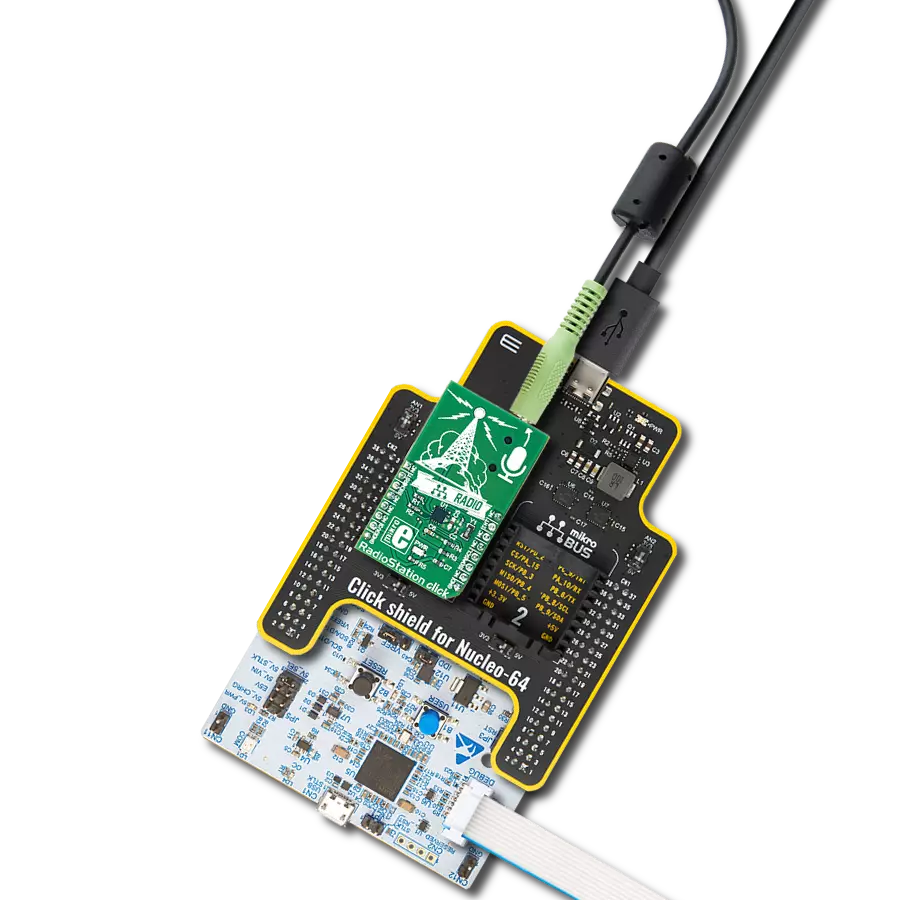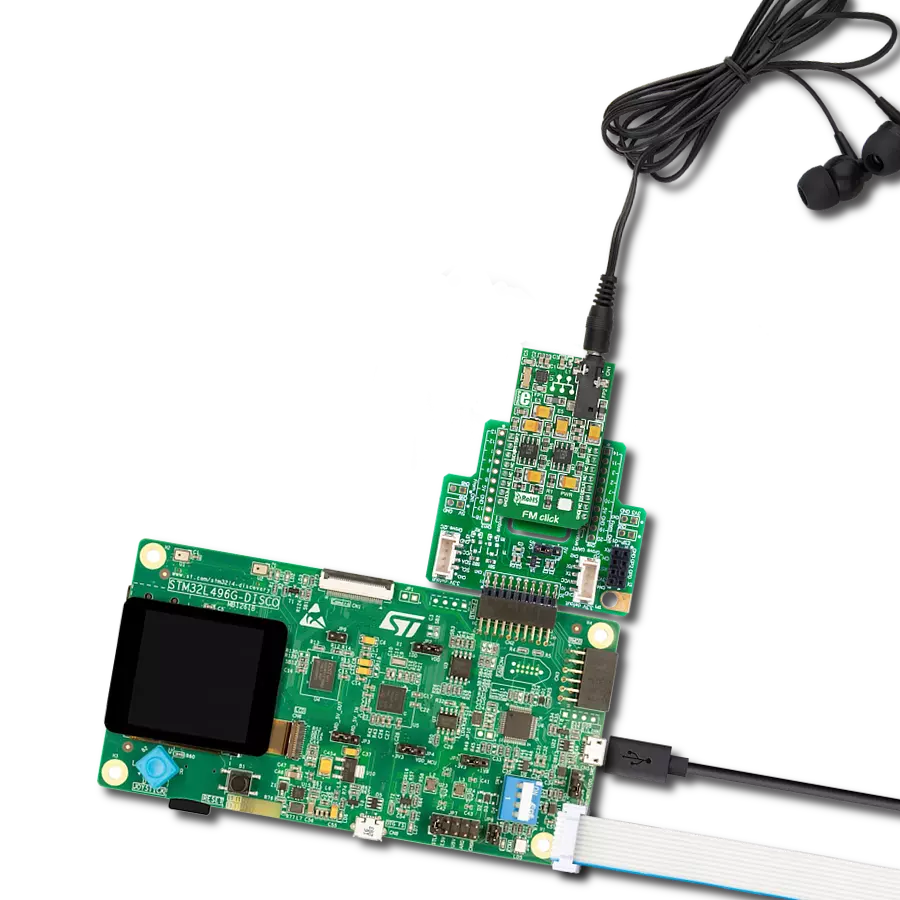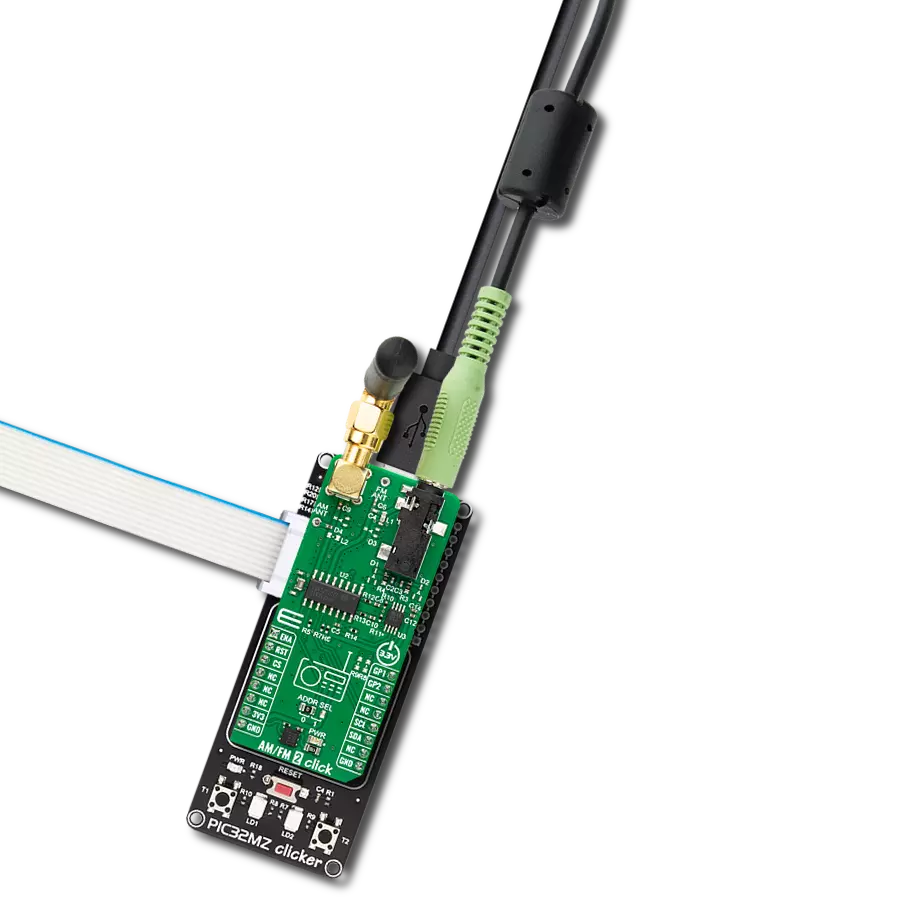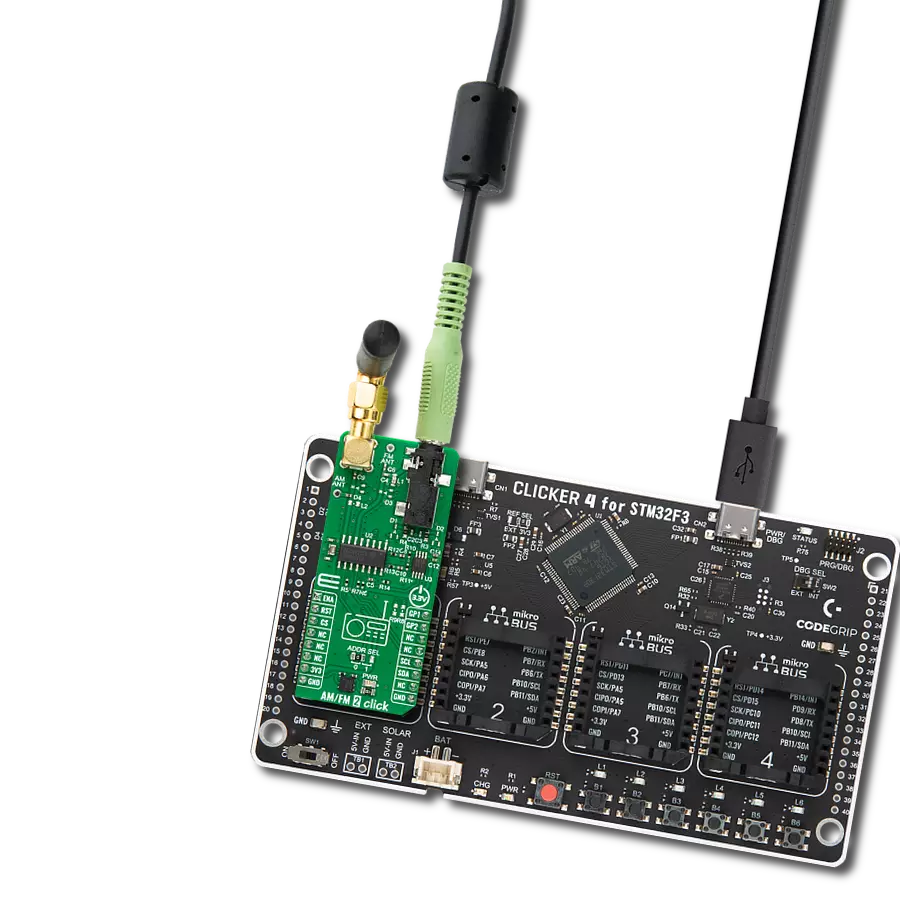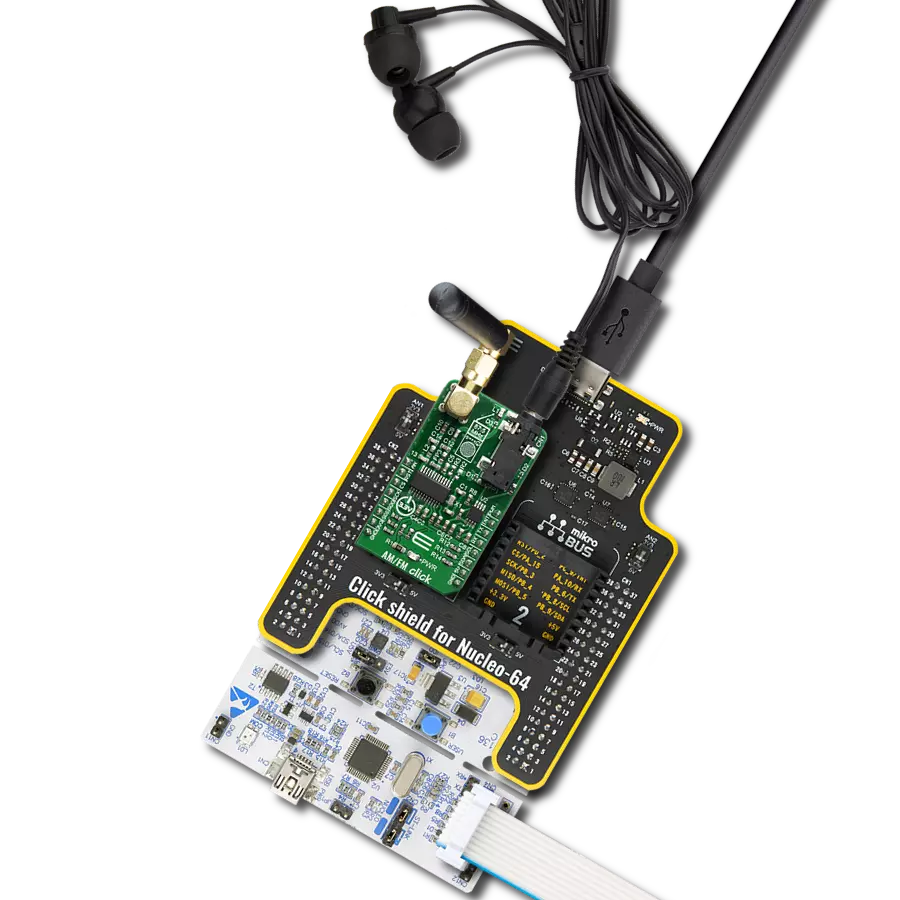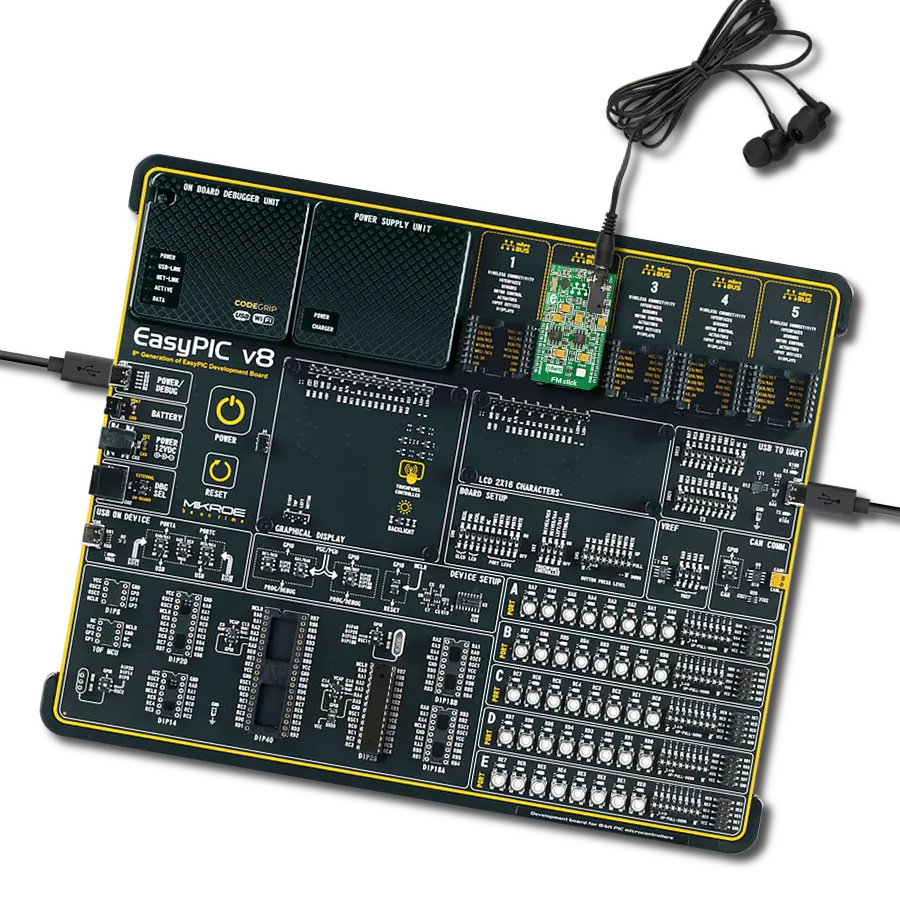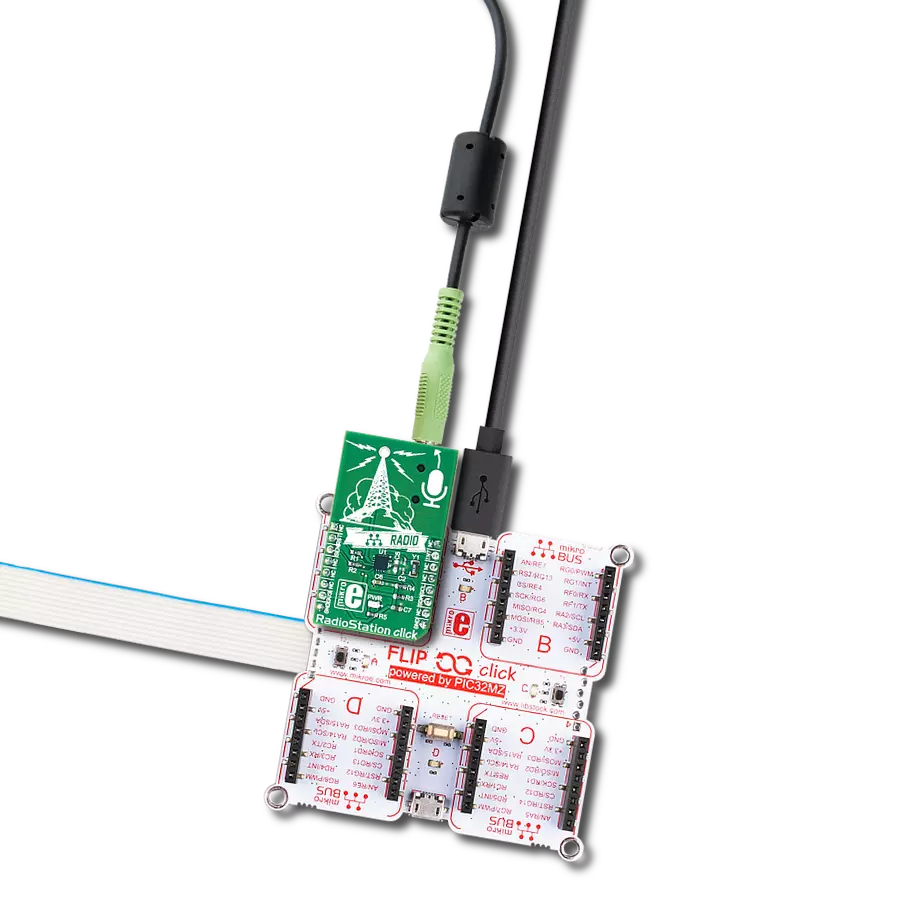Combined with the capability to broadcast both music and informational data, this project is a match for anyone looking to explore the world of FM broadcasting or to develop applications requiring FM signal transmission
A
A
Hardware Overview
How does it work?
RadioStation Click is based on the Si4713-B30, an FM radio transmitter with receive power scan from Silicon Labs. The RadioStation Click broadcasts the audio signal by utilizing the principles of FM radio broadcasting. The audio signal, brought to the low noise analog input terminals of the Si4713-B30 routed to a mini 3.5 female jack on board, is attenuated and converted into an alias-free, digital format. The digitalized audio is then sent to the digital signal processor (DSP) section of the Si4713-B30 IC, which provides modulation adjustment and audio dynamic range control of the signal for the best listening experience. The audio signal is processed to have the optimal dynamic qualities. Also, Si4713 has programmable low audio and high audio-level indicators that enable and
disable the carrier signal based on the presence of audio content. The Si4713-B30 IC can be used to measure the received signal. The antenna which is used to broadcast the signal can also be used to accept the incoming signal sent by the receiving device. Although it can be used both to receive and transmit signals, the antenna can't operate in both modes simultaneously. This feature can be useful when calibrating the transmission power of the Click board™. The Si4713-B30 integrates the complete transmit functions for standards-compliant unlicensed FM broadcast stereo transmission. The user application must comply with the local radio frequency (RF) transmission regulations. RadioStation Click uses a standard 2-Wire I2C interface to communicate with the host
MCU, supporting clock frequency of up to 400KHz. The I2C address can be selected over the SEN pin of the mikroBUS™ socket, depending on the logic state. The radio transmitter can be reset over the RST pin, which will, among others, disable analog and digital circuitry. The device will interrupt the host MCU over the INT pin if a condition occurs, such as the frequency exceeding the deviation level. This Click board™ can be operated only with a 3.3V logic voltage level. The board must perform appropriate logic voltage level conversion before using MCUs with different logic levels. However, the Click board™ comes equipped with a library containing functions and an example code that can be used as a reference for further development.
Features overview
Development board
PIC18F57Q43 Curiosity Nano evaluation kit is a cutting-edge hardware platform designed to evaluate microcontrollers within the PIC18-Q43 family. Central to its design is the inclusion of the powerful PIC18F57Q43 microcontroller (MCU), offering advanced functionalities and robust performance. Key features of this evaluation kit include a yellow user LED and a responsive
mechanical user switch, providing seamless interaction and testing. The provision for a 32.768kHz crystal footprint ensures precision timing capabilities. With an onboard debugger boasting a green power and status LED, programming and debugging become intuitive and efficient. Further enhancing its utility is the Virtual serial port (CDC) and a debug GPIO channel (DGI
GPIO), offering extensive connectivity options. Powered via USB, this kit boasts an adjustable target voltage feature facilitated by the MIC5353 LDO regulator, ensuring stable operation with an output voltage ranging from 1.8V to 5.1V, with a maximum output current of 500mA, subject to ambient temperature and voltage constraints.
Microcontroller Overview
MCU Card / MCU
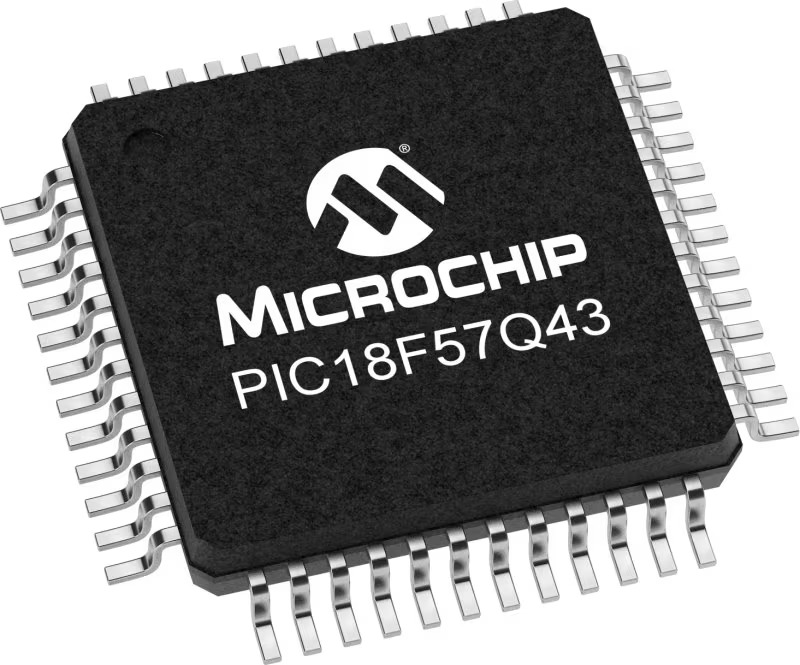
Architecture
PIC
MCU Memory (KB)
128
Silicon Vendor
Microchip
Pin count
48
RAM (Bytes)
8196
You complete me!
Accessories
Curiosity Nano Base for Click boards is a versatile hardware extension platform created to streamline the integration between Curiosity Nano kits and extension boards, tailored explicitly for the mikroBUS™-standardized Click boards and Xplained Pro extension boards. This innovative base board (shield) offers seamless connectivity and expansion possibilities, simplifying experimentation and development. Key features include USB power compatibility from the Curiosity Nano kit, alongside an alternative external power input option for enhanced flexibility. The onboard Li-Ion/LiPo charger and management circuit ensure smooth operation for battery-powered applications, simplifying usage and management. Moreover, the base incorporates a fixed 3.3V PSU dedicated to target and mikroBUS™ power rails, alongside a fixed 5.0V boost converter catering to 5V power rails of mikroBUS™ sockets, providing stable power delivery for various connected devices.
Used MCU Pins
mikroBUS™ mapper
Take a closer look
Click board™ Schematic

Step by step
Project assembly
Software Support
Library Description
This library contains API for RadioStation Click driver.
Key functions:
radiostation_get_asq_status- This function returns status information about the audio signal quality and current FM transmit frequencyradiostation_power_up- This function powers up the chip with default settingsradiostation_get_tune_status- This function returns status information which is set by radiostation_get_tune_measure, radiostation_set_tune_frequency or radiostation_set_tune_power
Open Source
Code example
The complete application code and a ready-to-use project are available through the NECTO Studio Package Manager for direct installation in the NECTO Studio. The application code can also be found on the MIKROE GitHub account.
/*!
* \file
* \brief RadioStation Click example
*
* # Description
* RadioStation Click can be used to broadcast the music via the FM radio band
* ( which operates in the frequency range of 76MHz to 108MHz ).
*
* The demo application is composed of two sections :
*
* ## Application Init
* Initialization driver enable's - I2C and sets transmit_frequency.
*
* ## Application Task
* In this example Radio Station Click is receiving signal from audio connector and broadcasting
* it on 100.00 MHz frequency.
*
*
* \author MikroE Team
*
*/
// ------------------------------------------------------------------- INCLUDES
#include "board.h"
#include "log.h"
#include "radiostation.h"
// ------------------------------------------------------------------ VARIABLES
static radiostation_t radiostation;
static radiostation_cmd_t radiostation_cmd;
static log_t logger;
static uint8_t buff[ 16 ];
// ------------------------------------------------------ APPLICATION FUNCTIONS
void application_init ( void )
{
log_cfg_t log_cfg;
radiostation_cfg_t cfg;
/**
* Logger initialization.
* Default baud rate: 115200
* Default log level: LOG_LEVEL_DEBUG
* @note If USB_UART_RX and USB_UART_TX
* are defined as HAL_PIN_NC, you will
* need to define them manually for log to work.
* See @b LOG_MAP_USB_UART macro definition for detailed explanation.
*/
LOG_MAP_USB_UART( log_cfg );
log_init( &logger, &log_cfg );
log_info( &logger, "---- Application Init ----" );
// Click initialization.
radiostation_cfg_setup( &cfg, true );
RADIOSTATION_MAP_MIKROBUS( cfg, MIKROBUS_1 );
radiostation_init( &radiostation, &cfg );
radiostation.transmit_frequency = 10000;
radiostation.status = 0xFF;
radiostation_default_cfg( &radiostation, &radiostation_cmd );
}
void application_task ( void )
{
radiostation_get_asq_status( &radiostation, &radiostation_cmd, &buff[ 0 ] );
Delay_ms ( 50 );
}
int main ( void )
{
/* Do not remove this line or clock might not be set correctly. */
#ifdef PREINIT_SUPPORTED
preinit();
#endif
application_init( );
for ( ; ; )
{
application_task( );
}
return 0;
}
// ------------------------------------------------------------------------ END
Additional Support
Resources
Category:FM




















